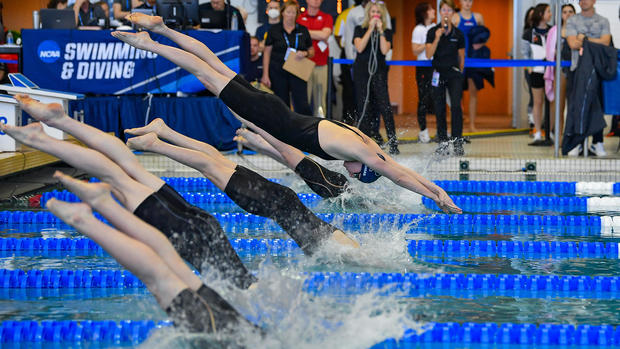Diving into the debate over trans athletes
Twenty-one-year-old Lucas Draper is not someone you'd want to challenge in the gym. Just watching his sit-up routine is enough to make your abs hurt. Draper is a junior on the men's swimming and diving team at Oberlin College in Ohio.
"I was in the water before I could walk," he told correspondent Lee Cowan. "I started swimming competitively when I was about nine."
Draper came here to compete from Australia. But after he broke his hand, he decided that this season he'd just compete on the men's diving team, instead, although you might not recognize him from a distance, wearing a women's bathing suit.
"So, I still wear the women's suit, 'cause I haven't had any sort of surgery," Draper said. "I would like to at some point."
The women's suit hides what a men's suit can't. Until last year, Draper had been competing on Oberlin's women's team. This past November, he began a regimen of testosterone therapy as part of his transitioning to a man.
"I was a tomboy from the moment I could walk," Draper said. "I always felt a little bit lost and a little bit like I didn't fit in."
He says he's happier now than he's ever been.
Cowan asked. "This is the first season that you've been competing as a man. How's it feel so far?"
"It feels good."
Draper's transition has been supported by his coaches and his teammates at Oberlin, but that kind of acceptance isn't enjoyed by all transgender athletes, especially trans women.
Twenty-two-year-old Lia Thomas is arguably one of the most controversial and yet accomplished collegiate trans swimmers competing today. For three years, she swam on the University of Pennsylvania's men's team, but after taking some time off, returned this season to swim with the women – and she has become a phenom. In a sport often defined by just fractions of a second, Thomas is sometimes so far ahead she's seen waiting at for her competitors to catch up.
NCAA rules require trans women athletes to take testosterone suppression therapy for one year before competing. Lia Thomas has been on it for twice that long.
And while her times have slowed since she was swimming as a man, her winning streak has sparked firestorm over just how to balance fairness and inclusion.
Dr. Michael Joyner is a physiologist who researches human athletic performance at the Mayo Clinic in Minnesota. "In many sports, men are, you know, 10% or 20% better on average," he said. "And if you look at the most elite performers, men are far, far and ahead of what women are able to do."
"And that's where the fairness question comes in?" asked Cowan.
"Absolutely."
After studying Lia Thomas' times from male to female, Joyner said statistically she is an outlier: "The emerging evidence is that there are legacy effects of testosterone, especially [for] people who have been through puberty as males, and had exposure to testosterone for prolonged periods of time."
He expects that Thomas' testosterone suppressants have indeed lowered her hormone levels down to those of cisgender women – those are women whose gender identities match the sex they were assigned at birth.
But Joyner says that hormone therapy can't reverse everything: "Height's probably not reversible, hand size, foot size. Some of the issues related to muscle mass, lung size, and other things probably are never gonna revert completely, if at all."
Joanna Harper, a visiting fellow studying transgender athletic performance at Loughborough University in England, said, "Trans women will maintain advantages. But are those advantages large enough to preclude meaningful competition? Not clear at all."
She wonders if the advantages that trans women may have may also come with some disadvantages: "The bigger bodies of trans women are now being powered by reduced muscle mass, reduced aerobic capacity. That can lead to disadvantages in things like quickness, recovery, endurance, etc."
Her published studies are among the few that have been done on trans athletes, a field that she got interested in as a competitive runner when she began her own transition from a man to a woman back in 2004.
"Within nine months of starting hormone therapy, I was running 12% slower," she said, "and that's the difference between serious male distance runners and serious female distance runners. As a scientist I was intrigued."
She's now in the process of conducting a more long-term study of trans athletes.
Cowan asked, "Nobody's really done that yet, on this scale?"
"On any scale," Harper replied.
That's in part because transgender people only make up an estimated 1% of the population. Elite trans athletes are only a tiny fraction of that.
That said, many in competitive swimming say we don't need exhaustive studies to decipher what they say is plainly evident.
Nancy Hogshead-Makar, who won three Gold Medals at the 1984 Olympics in Los Angeles, said, "To have somebody competing who does have this unfair advantage, even if they don't win, it still corrupts the field. They think that women should just move over and say, 'Here you go. You take these spots.'"
She now heads Champion Women, an advocacy group for women's equality in athletics.
"Lia Thomas has already greatly impacted women's sports," Hogshead-Makar said. "When Lia is in the finals, it means another woman doesn't make it into the finals."
Cowan asked, "You're not against trans athletes, you're just against trans women competing in the women's category?"
"Correct. When it comes to competitive sports is where I would draw the line. I do think that trans gender people have a really hard time in society, and I want that to be easier. But we can't ask women to give up what we've worked so hard for, so that that transgender women are able to compete."
That argument has already forced some changes. This year, mid-season, the NCAA announced that it was abandoning its rules that have allowed trans athletes to compete since 2011. It will now in the future leave it up to the governing bodies of each sport to come up with their own rules.
At the legislative level, laws that ban trans women and girls from participating in sports are getting more and more common; 22 states have introduced bills just like that this year alone.
Schuyler Bailar was the first openly trans man in Division 1 swimming. He's now an advocate for transgender inclusion. "These bills are devastating," Bailar told Cowan. "They are telling trans kids they do not belong, even the ones who don't wanna play sports, because it says, 'Hey, you don't belong,' in one of the primary activities that children partake in."
"Is there any middle ground in this debate?" asked Cowan.
"I don't think that there is space to say, 'Yes, I affirm your identity, but I don't in sport," Bailar replied. "You can't divide me in half and have my transness and my masculinity show up here, and not over here."
All season, he's been cheering Lia Thomas on, but he worries if she's excluded from sports, just where does it stop? "At what point is a woman too tall or her hands too big? At what point is a woman not woman enough?"
"Does she go in with an advantage?" Cowan asked.
"I think biodiversity exists everywhere," Bailar said, "and the reality is people win and lose all the time, and nobody consider that unfair, until it is a marginalized person, specifically a Black or Brown women and/or a trans woman."
All eyes were on Lia Thomas recently at the NCAA National Finals, where she didn't break any records, but she did become the first known transgender athlete to win a Division I championship. While some celebrated, others were angry. Clearly the debate is far from over.
As for Lucas Draper, he's really not sure what the answer is, but a willingness he says to dive into the debate is at least a start at finding a solution.
"People who identify as transgender are very much in the minority, and people just don't understand where people like me are coming from," Draper said.
"Where are you coming from?"
"I just wanna be me," he replied. "And me isn't my private parts. It's who I am inside."
For more info:
- Lucas Draper (guest editorial for Swimming World magazine)
- Schuyler Bailar (pinkmantaray.com)
- Schuyler Bailar on Instagram
- Photos of Schuyler Bailar by Ray Yeager, and by Sydney Altschuler (Sydney Claire Photography)
- Nancy Hogshead Makar (Champion Women)
- Dr. Michael Joyner, Mayo Clinic, Rochester, Minn.
- Joanna Harper, School of Sport, Exercise and Health Sciences, Loughborough University, Loughborough, England
Story produced by Deirdre Cohen. Editor: Ed Givnish.







